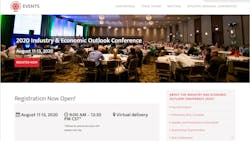The National Fluid Power Association will convene its virtual Industry & Economic Outlook Conference on Aug. 11-13. In three half-day sessions, the event offers the fluid power industry a one-stop opportunity to gather information from some of the world’s top experts.
Speakers from ITR Economics, Oxford Economics, the Kellogg School of Management and IHS Markit will deliver three days of insights into the effects of the pandemic, the state of global politics and market forecasts for the industry as a whole as well as for several vertical markets.
Because of the importance of the sessions and the quality of the speakers, NFPA is making the event available to everyone. The virtual format is designed to allow you to see several presentations during the day as well as network with speakers and other practitioners in the fluid power industry. Registration is available at the NFPA website at www.nfpa.com.
It’s easy to predict that three days of this kind of information can’t help but make us all better informed about the big world we live in and the smaller world we work in. The biggest question to ask after any of these events is: What are we going to do with the data?
In a digital age, we can measure anything we want in our workplace—from air pressure to temperature to inventory. Inexpensive sensors and powerful analytics have combined to give us great insight into our operation in the smallest detail. We easily can see how our equipment is performing and, to an equal extent, how our people are performing. Most of the time, in most circumstances, it confirms to us that our plants run well, and are well run. And that’s all great.
But that concept of continuous improvement we discussed last month again comes into play. Since everyone has access to the data, and because we live and work in a competitive environment, we always should look to how to make our operation better than good. Data collection and analytics is the first step down that process.
From there, we have to find the places where good can become better. We engage not just the artificial analytics, but also the human assessment needed to activate your team to make change. Just knowing the data isn’t good enough; it has to be followed by action.
The pandemic itself has been an exercise in data analytics and action in response to the data. We can argue whether the information gleaned from the data was followed with effective action, but it proves the point that how you choose to act on data is more important than the data itself.
That’s why the NFPA’s Industry & Economic Outlook Conference really is the first step in a process for all attendees. You’re going to see a lot of data sets, a lot of bar charts and a lot of projections. There will be a lot of projections. Economists and weather forecasters love to tell us what is going to happen next. It’s easy to talk about a thunderstorm and a recession when you’re in the middle of it. In both cases, what you really want to know when it’s safe to go outside again.
But the data has value and rigor behind it in the same way as the sensors on your compressor can tell you what’s going on. The information gets you knowledge. It may even get your attention. The real question you need to be prepared to ask is, “What do I do next?”
My experience tells me that if you go in prepared to answer that question from the start, the faster you’ll be able to turn this data—or any data—into real results.
About the Author
Bob Vavra
Senior Content Director, Power & Motion and Machine Design
Bob Vavra is the Senior Content Director of Power & Motion and its sister publication Machine Design. Vavra has had a long career in publishing, media and events. He has covered all aspects of manufacturing for the past 20 years and is a regular attendee at events such as IMTS and Hannover Messe. Vavra is also a sought-after webcast moderator and event emcee, and has presided over events in the U.S., Germany and China.

Leaders relevant to this article:
